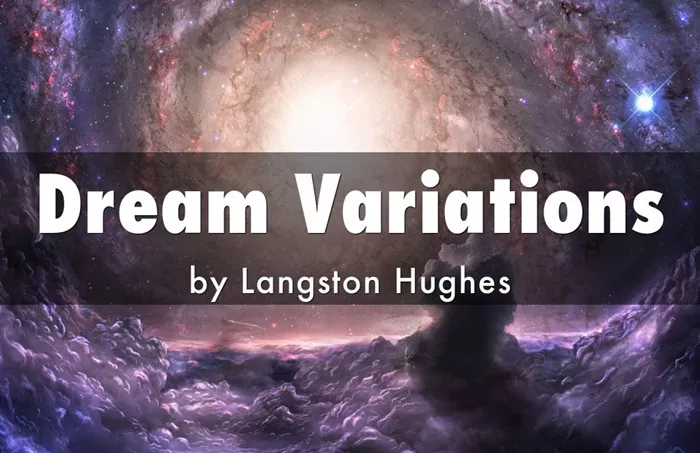Welcome to Poem of the Day – Dream Variations by Langston Hughes
Langston Hughes is widely recognized as one of the most important voices of the Harlem Renaissance, a period in the 1920s when African American culture flourished. One of his most famous works is the poem “Dream Variations,” written in 1926. This short, but impactful, poem captures a deep yearning for freedom and the beauty of dreams, while subtly addressing racial themes in America.
Dream Variations Poem
To fling my arms wide
In some place of the sun,
To whirl and to dance
Till the white day is done.
Then rest at cool evening
Beneath a tall tree
While night comes on gently,
Dark like me—
That is my dream!
To fling my arms wide
In the face of the sun,
Dance! Whirl! Whirl!
Till the quick day is done.
Rest at pale evening . . .
A tall, slim tree . . .
Night coming tenderly
Black like me.
Dream Variations Explanation
Overview of the Poem
“Dream Variations” consists of two stanzas, each expressing a desire to escape from the harsh realities of life and experience a world full of peace and joy. In the first stanza, the speaker dreams of dancing “in the sun,” suggesting a place of light, warmth, and joy. In contrast, the second stanza expresses a desire to rest “at the dusk,” a time of peace and reflection. These two stanzas contrast light and darkness, day and night, illustrating the speaker’s longing for both freedom and rest.
First Stanza: Dancing in the Sun
The first stanza of “Dream Variations” begins with the speaker imagining a carefree, joyful moment where they “dance in the sun.” Dancing, in this case, symbolizes the freedom to express oneself without constraints. The sun represents life, energy, and vitality—qualities the speaker yearns for.
Hughes uses this image to convey the sense of vitality and hope that comes with dreaming of a better life. The speaker’s dream, however, is not purely an idealized escape but a deeply personal wish for liberation from oppression. The sunlight here can be seen as symbolic of a brighter future, one in which the speaker is free to fully enjoy life.
Second Stanza: Resting at Dusk
The second stanza shifts in tone. It moves from the warmth of sunlight to the coolness of dusk, a time when the day transitions to night. The speaker imagines themselves “resting at the dusk,” seeking peace and quiet after a day full of struggle. Here, dusk represents a time of calm and reflection, but also the complexities of life that include both light and darkness.
The phrase “dusk” may also suggest a kind of melancholy, reflecting the fact that the speaker’s desires for freedom are not always fully realized. The imagery of dusk can symbolize the challenges of living in a world filled with prejudice, where rest and peace are not easily attained.
Themes in “Dream Variations”
One of the central themes in “Dream Variations” is the contrast between dreams and reality. Hughes presents the dream as a space for liberation, but also acknowledges the limitations imposed by society, especially on African Americans. The shift from the brightness of the sun to the darkness of dusk mirrors the struggle of African Americans in a society where they are not fully accepted or free.
Another theme in the poem is the desire for balance between joy and peace. The speaker craves both the vitality of the sun and the tranquility of the dusk, suggesting a yearning for harmony in life. This duality reflects the complexities of human existence, where moments of happiness and sorrow coexist.
The Influence of Race
Hughes was deeply concerned with racial issues, and much of his work highlights the struggles of African Americans in a segregated society. “Dream Variations” subtly addresses these racial tensions. The speaker’s wish to dance in the sun could be interpreted as a desire for the freedom to live openly and without fear, something that African Americans at the time could not always experience due to racial discrimination.
In the second stanza, the reference to resting at dusk may reflect the weariness of the African American experience in a society filled with obstacles. Dusk could symbolize both the quiet end of a day and the end of an era, hinting at the long road toward racial equality.
Conclusion
Langston Hughes’s “Dream Variations” is a powerful and emotional poem that uses imagery of light and dark to explore themes of freedom, peace, and racial identity. The speaker’s dreams of dancing in the sun and resting at dusk represent a longing for both joy and calm, highlighting the complexities of human existence. Through this simple yet profound poem, Hughes captures the aspirations of many who seek to overcome struggles and find peace in their lives, particularly in a world shaped by racial division. The poem continues to resonate with readers for its universal themes and its poignant portrayal of the African American experience.

